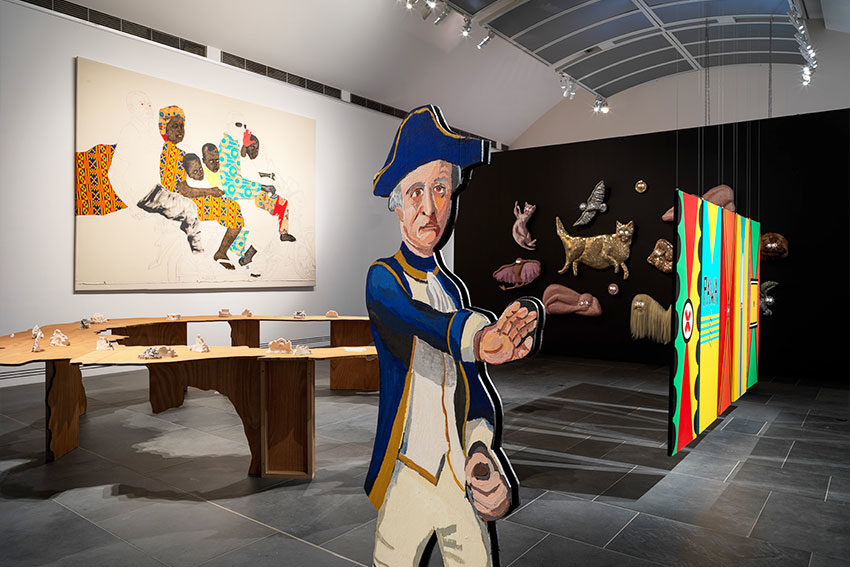Ramsay Art Prize winner Vincent Namatjira adds a new dimension to 'Captain Crook' art tradition

With the average income of a visual artist in Australia hovering around the $50,000 mark, the Ramsay Art Prize of $100,000 is a real slingshot for creative talent into pay-the-bills territory with street cred value-add.
The experience of wandering through an exhibition of finalists in art prize shows is always tempered by the feeling that any number of works might have caught the judges’ eyes. Viv Miller’s animation, Folk, works the faux digital parameters of contemporary signage to cleverly expose relationships between the hand-drawn and the synthesised. Pierre Mukeba’s capture of a family moment, all aboard a remarkably robust motor bike, strikes an arresting, heroic note – an icon for our times even. Sera Waters’ Falling: Line by Line demonstrates refreshing conceptual agility in reimagining a unit of humble long-stitch as an outsized iconic Australian landscape without a Rorschach blot in sight. Art-as-art tragics like myself might have felt a twinge of missed-the-prize pity for Lina Buck’s In Context (Actions Becoming) and Tom Freeman’s Dippers, given both works’ subscription to process-led serialisation, which, as more and more artists enlist to save the world, is beginning to look like a retreat from it.
Vincent Namatjira’s Close Contact took out the prize. Engaging and quirky as his images are, there is a fragility about their capacity to carry both the artist’s parodic intent and a weight of community expectations that his art ‘take it up to’ populist narratives, particularly as many of his previous subjects have implied connections between leadership, wealth, power and influence. In this work he has stepped out of his own shadow and cast aside the props that the pictorial frame and the naïve affords.
The strategy of casting Cook and self as a duality in a back-to-back profile cuts through. Namatjira fans will be primed to see where this format swerve will take the artist. Politically, Close Contact is the hottest ticket in the room. Namatjira has joined a DissCook club of some note.

Adelaide was an early member with its Adelaide Festival mural Aboriginals Discovered Cook, commissioned by the Adelaide Festival of Arts for the 1982 festival. Daniel Boyd’s painting We Call Them Pirates Out Here (2006) shares common ground with Namatjira’s ‘Cook’ in that this work is an open parody of Emanuel Phillips Fox’s The landing of Captain Cook at Botany Bay, 1770 (1902). This same Phillips Fox painting was referenced by Namatjira when he was developing his ideas for Close Contact.
In Boyd’s interpretation, Cook with a black eye patch, standing in front of a skull and cross bones embellished Union Jack, is cast as a marauding pirate and no better than a land-grabbing treasure hunter. It has been suggested that a one-eyed Cook symbolises the ‘one-eyed’ version of settlement history.
The idea of ‘Captain Crook’ has been cleverly exploited by another Indigenous artist, Jason Wing, who, in a sculptural bust titled Australia was Stolen by Armed Robbery (2013), has Cook wearing a balaclava, as if a bank robber. It is interesting to note that the artist made this work in response to looking at the (recently vandalised) bronze sculpture of Cook in Hyde Park, Sydney, with its inscription ‘Discovered this Territory, 1770’.
In Gordon Bennett’s Possession Island (1991) the artist riffed off Samuel Calvert’s engraving, Captain Cook taking possession of the Australian continent on behalf of the British Crown AD 1770 (c. 1853- 1864) with its reassuring scenes of peaceful sociability. Bennett’s mashup of this image speaks for his understanding of how master narratives fragment or obscure alternative histories.
Michael Cook’s Undiscovered (2010) photographic series subverts the concept of ‘discovery’ by disposing actors (Aboriginal people dressed in British maritime uniforms, native animals and emblems of Western technology such as a wheelbarrow and ladder), on a beach somewhere to reverse the conventional perspective of Europeans looking onto the land.

This long list of Cook-centric art practice must include Karla Dickens’ The nips are getting bigger/I’d better go and get something harder (2015) collection of Captain Cook-shaped whisky bottles, translated into a commentary on the devastating influences of alcohol and disease on Indigenous communities.
Ben Quilty, when talking about his mutation of Cook’s visage in his well-known portrait series, refers to Indigenous film maker Warwick Thornton’s opinion that Cook represents to him “the beginning of the end for his culture”. In this context, Namatjira’s reversal of realities is sitting on a powder keg of feelings shared by many in both Indigenous and non-Indigenous communities. So, yes, the Ramsay can be celebrated a Dash for the Cash and good luck to the winner. But it also contains beating hearts for whom art is everything. See the show. Feel the pulse.
Ramsay Art Prize
Art Gallery of South Australia
Until 25 August 2019